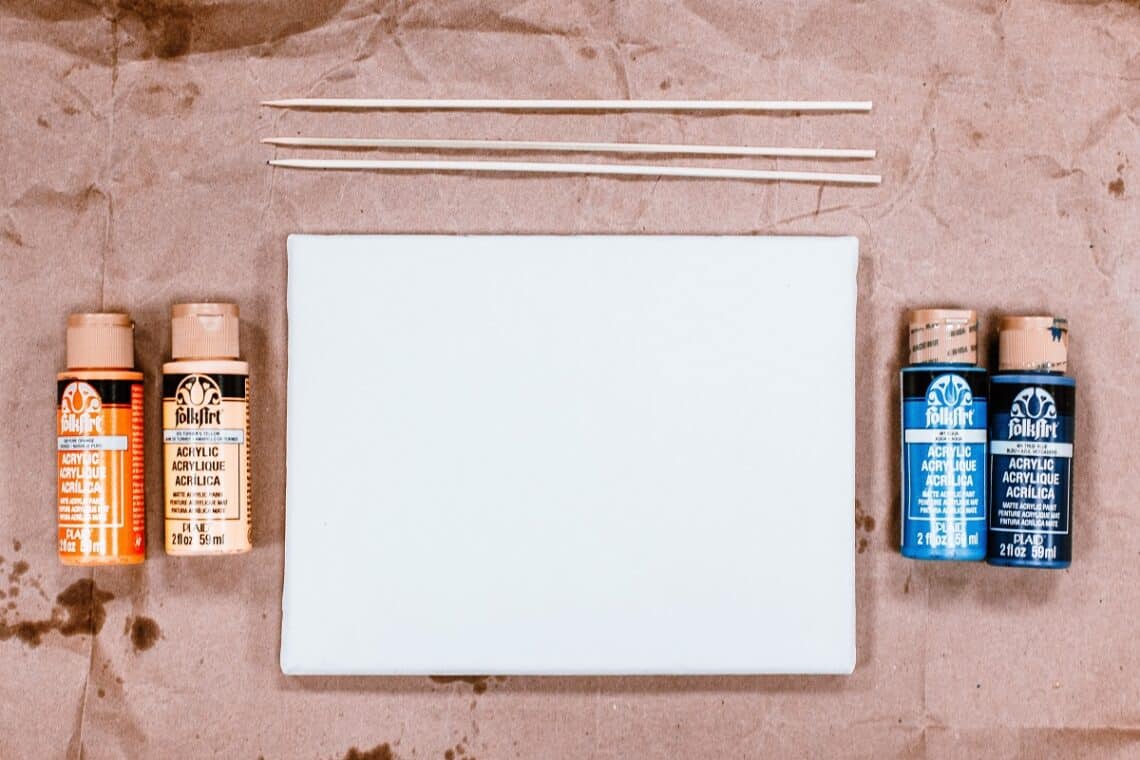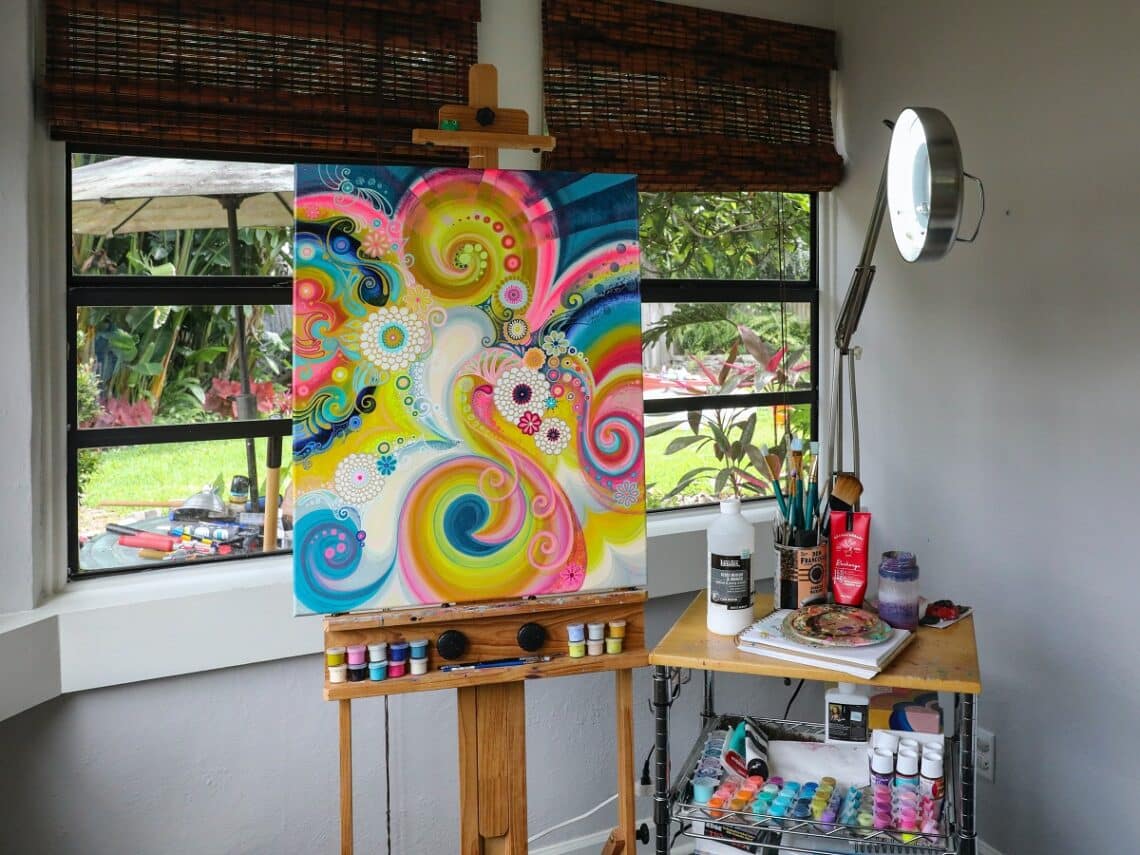Acrylic paint is preferred by numerous artists and painters today for the vibrancy it produces. And with the best brushes for acrylic painting, anyone can create truly amazing artworks using these paints.
But, the painting process using acrylic paints is somewhat time-consuming. Before starting out, you not only need to know which canvases to choose but also how to clean acrylic paint brushes.
That automatically raises the question, how long does acrylic paint take to dry? It usually takes around an hour or so, but most painters leave their paintings to dry overnight. Acrylic paints are pretty vulnerable to dust and grime, so if you leave them in the open, they can become dirty.
That said, cleaning an acrylic painting is no easy job. You need to follow certain guidelines during the cleaning process. And, that has been discussed in detail in this article.
So, without further ado, let’s get to it!
Evaluate The Painting
![How To Clean An Acrylic Painting [All You Need To Know] 5 Young beautiful smiling woman with dark curly hair sitting on chair drawing amazing picture on canvas happily looking in camera in cozy art workshop. Evaluate the painting.](https://dev.architecturelab.net/wp-content/uploads/2022/08/How-To-Clean-An-Acrylic-Painting-2.jpg)
Before you get started with the cleaning process, it is important to examine the painting carefully. That will help you determine how to proceed with the cleaning process.
For this purpose, we recommend that you undertake a surface inspection of the painting. If you see that there is a lot of loose dirt and dust on the surface, the cleaning process will be straightforward.
If you do not see any loose dirt, but the painting still looks dirty and dull, it implies that the dirt and grime have become embedded in the painting. In that case the cleaning process will take a bit more time and effort.
In any case, once you have carefully examined the painting, it is time to start cleaning it. The method used for cleaning has been discussed in the subsequent sections.
Removing Dirt From The Surface Of An Acrylic Painting
Unlike oil paint, the surface of an acrylic painting is much more vulnerable to dust and dirt. If you keep the painting out in the open, then the airborne dust will get deposited on the surface. So, to clean the painting, you will need to follow the steps below.
Step 1: Make Sure The Painting Is Dry
Before you brush off the dirt, you should make sure that the painting is completely dry. If you brush it when there is moisture on the surface, your painting will get smudged and ruined.
For a new painting, you’ll need to wait until it dries up completely. And, if it is an older painting, then you’ll need to make sure that there is no water or moisture on the surface.
Step 2: Brush Off The Surface Dust
After you have ensured that the surface is dry, you need to brush off the dirt from the surface using a soft-bristled brush. Before using it on the painting, you will need to make sure that the brush is clean and dry as well.
We suggest that you use a hair or a makeup brush since they have fine and soft bristles that will not harm the painting. Never use a brush with hard bristles, as that might scrape and scratch your painting.
You need to lightly brush the surface to wipe the dust off it. It is recommended that you use long strokes starting from one of the corners. Avoid applying too much pressure, as that can cause visible scratches on the painting, even if you are using a soft brush.
In case there is too much dust on the surface, you can try using a vacuum cleaner alongside the brush. Hold it close to the painting surface to capture the dirt and debris, and prevent it from making a mess.
Step 3: Clean The Frame And Surroundings
Once the surface is clean, you should clean the frame of the painting, as well as the surroundings. This is an important step, especially if you have put the painting on display. You can use the same brush and a vacuum to dislodge dust and dirt off the frame and surroundings.
As a precautionary measure, you should regularly dust off the painting and its surroundings to keep it clean for a long time.
Cleaning Dirt And Grime From The Painting
If your painting has become dull and dirty, and you notice no loose dust on the surface, then you will need to clean it more extensively. In this case, you will need to use a solution of soap and water.
Just be careful while using soapy water to clean an acrylic painting as it may smudge your painting. Also, avoid using any other chemicals and solvents in your paint, as these external agents can damage it permanently. .
With that said, here is the process that you need to follow to clean your acrylic painting.
Step 1: Mix A Little Bit Of Soap With Water
Take a large bowl or a container, and fill it with warm water. Then, put a few drops of liquid soap or detergent, and stir the water with a stick or a spoon to dissolve it uniformly. Keep stirring until you see bubbles on the surface, which means that the solution is ready.
Do not take more than three to four drops of the liquid detergent or soap, or else the solution will become too strong and damage the acrylic surface. The detergent will help emulsify the dirt particles and grime from the painting without damaging the color.
Step 2: Dip A Cloth Or Sponge In The Solution
In this step, you need to take a soft piece of cloth and dip it slightly in the soap solution. The cloth should not be rough as that can smudge your painting. Ideally, we suggest that you use a piece of cloth made of microfiber or cotton. If you don’t have that, you can dip a soft sponge in the solution.
Squeeze the cloth or sponge hard to drain the excess water. If you use a sponge, give it a little shake to remove any excess soap from it. Your aim is to make it as dry as possible, preferably to the point that it is just barely damp. Once you reach that point, you can use it to wipe the painting.
Step 3: Carefully Wipe The Painting Surface
Before you start, we suggest that you test the soap solution in one small corner of the painting. This way, you can see what effect the solution will have on the painting. If you notice any smudging, you should try to dry the cloth even more or dilute the solution further by adding more water.
Once you notice that there is no visible smudging, you can wipe the rest of the painting. Move the damp cloth or sponge across the acrylic paint layer using very light strokes. If you are using a cloth, you can give it a few folds to make it easier to apply.
You can make multiple passes over the acrylic paint layer if necessary. Allow the surface to dry before each pass, minimizing the chances of the paint getting smudged.
To dry it quickly, you can use a fan or gently blow over the painting. With every successive pass, try to remove as much of the dirt layer as possible without applying too much pressure.
Apply Varnish To The Paint Surface
![How To Clean An Acrylic Painting [All You Need To Know] 6 Apply varnish to the paint surface](https://dev.architecturelab.net/wp-content/uploads/2022/08/How-To-Clean-An-Acrylic-Painting-4.jpg)
Now that you know about cleaning acrylic paintings, it is time you learn about varnishing them. This is not exactly a cleaning process, but it is a process by which you can protect your acrylic paintings in the long run.
Varnishes provide surface protection for acrylic paints without compromising the painting. They are transparent resin that do not react with acrylic paints, so there is no chance of your painting getting ruined or smudged. The varnish forms a thin film over the paint layer that protects it against dust, grime, scratches, and abrasion.
Varnishing acrylic paintings is fairly straightforward, and you can do it even without any prior knowledge. In fact, if you use water-soluble varnish, it becomes as simple as applying another coat of paint.
All you need to do is dissolve the varnish in some water and carefully apply it over the dried acrylic paint film using a soft sable brush. In the case of a regular varnish, you simply need to spray it over the painting or apply it with a brush. After you apply the varnish, leave the painting to dry overnight.
Since it is transparent, it can be difficult to ascertain if you have applied varnish over the entire painting. If you miss any spot, that part will remain unprotected. In order to avoid that, we suggest that you use straight, uniform strokes to apply varnish.
Alternatively, you can inspect the painting under a light to see if you have missed out on any spot. A varnished painting acquires a shiny finish, so the areas without varnish can be detected easily, as they will lack shine.
Other Protective Measures For Acrylic Paintings
Aside from applying varnish, there are quite a few measures that you can take to protect your acrylic paintings. These have been discussed below.
1. Use A Protective Covering
To keep your acrylic paintings safe from dirt, you can wrap them with a protective covering. You can use plain plastic wrap or bubble wrap to cover them before putting them into storage. We suggest that you use bubble wrap since that provides some cushioning and prevents any scratches or damages to the painting.
2. Keep The Painting In A Dust-Free Environment
You should always store acrylic paintings in a dust-free environment because these are more vulnerable to dust, as we have previously stated.
If you keep them on display, then make sure to cover the paintings inside an airtight glass case. You can use protective framing if it is not possible to keep it in a large glass case. That way, you can keep it safe from dust without compromising on its portability. Furthermore, the framing will prevent physical damage to the painting.
Make sure to display paintings in areas where there is very low traffic. Mop the floors and vacuum the walls regularly to keep the surrounding environment as clean as possible. Also, avoid keeping the paintings near smoke and soot.
3. Minimize Light Exposure
Similar to most other types of paint, excessive exposure to light can degrade acrylic paint as well. Prolonged exposure to ultraviolet light can damage the acrylic paint layer, due to which the painting may get faded.
To avoid this, you need to keep your acrylic paintings away from direct sunlight. You can store them in a dark place to minimize their exposure to light. Alternatively, you can wrap them in black or brown paper to protect them from bright lights.
If you want to keep your paintings on display, then make sure to keep them indoors and away from any doors or windows. For illuminating the painting, you can use a soft light source so that fading can be prevented.
4. Maintain A Proper Temperature
Acrylic resins are sensitive to any changes in ambient temperature. With an increase in temperature, the paint gets softened, which makes it susceptible to damage. Conversely, if the ambient temperature is too cold, then your acrylic paintings may develop cracks.
So, you need to store your acrylic paintings in a moderately cool and dry environment. Make sure to keep the temperature between 65 and 80 degrees Fahrenheit. Also, keep them away from restrooms, kitchens, or any other place where there is a lot of moisture. That will prevent the growth of mold and mildew on your paintings.
How To Clean An Acrylic Painting Frequently Asked Questions ?
Is acrylic paint waterproof?
While the resin in acrylic paint is water-resistant to some extent, it does not provide a waterproof coating on your painting. So, if it is exposed to water, it might get washed off or smudged. That is why you should never wash or scrub the paintings with water. If you wish to make it waterproof, you can apply a layer of varnish on top of the paint.
Can you use mineral spirits to wash acrylic paintings?
Mineral spirits should never be used to clean acrylic paintings. This is because mineral spirits are not compatible with acrylic paints, which typically use a water-based solvent. If you use it, the adhesion between the paint resin will be reduced, due to which the colors will fade out or wash away completely.
Can you use compressed air to clean acrylic paintings?
Yes, you can use compressed air to clean acrylic paintings. You can blow off the dirt deposited on the surface by using this method. And, since there is no direct contact with the painting, it is a very effective method for dirt removal. However, it can only be used to remove loose dust particles and is not very effective at removing dirt and grime embedded on the surface.
![How To Clean An Acrylic Painting [All You Need To Know] 7 How to clean an acrylic painting final words](https://dev.architecturelab.net/wp-content/uploads/2022/08/How-To-Clean-An-Acrylic-Painting-3.jpg)
How To Clean An Acrylic Painting Final Words
And that’s all that we have to say about cleaning acrylic paintings. The processes we have discussed above are the most common techniques used by seasoned artists and art restorers to clean acrylic paintings.
We have also discussed some of the methods that you can use to protect your paintings from getting dirty. These techniques and methods are used across institutions involved with fine art conservation. So, they can be used to prevent your paintings from fading over time as well.
However, if you are not feeling so sure about some of the more delicate techniques we have discussed, you can always seek help from professional art conservators. But, it is our belief that if you follow the instructions accurately, you can get them done on your own.
With that, it’s time to wrap up this guide. See you later, folks!







![How To Clean An Acrylic Painting [All You Need To Know] 1 How to clean an acrylic painting](https://dev.architecturelab.net/wp-content/uploads/2022/08/How-To-Clean-An-Acrylic-Painting-1.jpg)